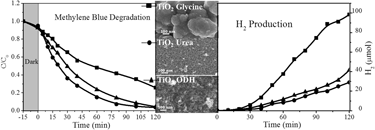Crossref Citations
This article has been cited by the following publications. This list is generated based on data provided by
Crossref.
Soman, Bhaskar
Challagulla, Swapna
Payra, Soumitra
Dinda, Srikanta
and
Roy, Sounak
2018.
Surface morphology and active sites of TiO2 for photoassisted catalysis.
Research on Chemical Intermediates,
Vol. 44,
Issue. 4,
p.
2261.
Manju, Janoha
and
Joseph Jawhar, Soosai Michael
2018.
Synthesis of magnesium-doped TiO2 photoelectrodes for dye-sensitized solar cell applications by solvothermal microwave irradiation method.
Journal of Materials Research,
Vol. 33,
Issue. 11,
p.
1534.
Thoda, Olga
Xanthopoulou, Galina
Vekinis, George
and
Chroneos, Alexandros
2018.
Review of Recent Studies on Solution Combustion Synthesis of Nanostructured Catalysts.
Advanced Engineering Materials,
Vol. 20,
Issue. 8,
Liu, Shuilian
Chen, Jianlin
Xu, Difa
Zhang, Xiangchao
and
Shen, Mengyao
2018.
Enhanced photocatalytic activity of directZ-scheme Bi2O3/g-C3N4composites via facile one-step fabrication.
Journal of Materials Research,
Vol. 33,
Issue. 10,
p.
1391.
Ganji, Parameswaram
and
Roy, Sounak
2019.
Trade-Off between Acidic Sites and Crystallinity of the WO3–TiO2 Catalyst toward Dehydration of Glucose to 5-Hydroxymethylfurfural.
Energy & Fuels,
Vol. 33,
Issue. 6,
p.
5293.
Li, Shixiong
Mo, Qiaoling
Lai, Xiaoxia
Chen, Yufeng
Lin, Chuansong
Lu, Yan
and
Liao, Beiling
2019.
Inorganic coordination polymer quantum sheets@graphene oxide composite photocatalysts: Performance and mechanism.
Journal of Materials Research,
Vol. 34,
Issue. 18,
p.
3220.
Thoda, O.
Xanthopoulou, G.
Vekinis, G.
and
Chroneos, A.
2019.
Influence of Various Parameters on the SCS Ni/NiO Nanostructures and their Mechanism of Formation.
Eurasian Chemico-Technological Journal,
Vol. 21,
Issue. 3,
p.
215.
Zammouri, Lobna
Aboulaich, Abdelhay
Capoen, Bruno
Bouazaoui, Mohamed
Sarakha, Mohamed
Stitou, Mostafa
and
Mahiou, Rachid
2019.
Synthesis of YAG:Ce/ZnO core/shell nanoparticles with enhanced UV-visible and visible light photocatalytic activity and application for the antibiotic removal from aqueous media.
Journal of Materials Research,
Vol. 34,
Issue. 08,
p.
1318.
Wu, Shizi
Xie, Yao
Zhang, Xianmei
Huang, Zhaohui
Liu, Yangai
Fang, Minghao
Wu, Xiaowen
and
Min, Xin
2019.
In situ synthesis of adsorptive β-Bi2O3/BiOBr photocatalyst with enhanced degradation efficiency.
Journal of Materials Research,
Vol. 34,
Issue. 20,
p.
3450.
Musembi, M. K.
Dejene, F. B.
Ahemen, I.
and
Tshabalala, K. G.
2020.
The effect of various fuels on the yield, structural and optical properties zinc zirconate nanocomposite.
Applied Physics A,
Vol. 126,
Issue. 8,
Habibi-Yangjeh, Aziz
Asadzadeh-Khaneghah, Soheila
and
Ghosh, Srabanti
2020.
Anchoring Bi4O5I2 and AgI nanoparticles over g-C3N4 nanosheets: Impressive visible-light-induced photocatalysts in elimination of hazardous contaminates by a cascade mechanism.
Advanced Powder Technology,
Vol. 31,
Issue. 7,
p.
2618.
Payra, Soumitra
Ganeshan, Sankalp Koduvayur
Challagulla, Swapna
and
Roy, Sounak
2020.
A correlation story of syntheses of ZnO and their influence on photocatalysis.
Advanced Powder Technology,
Vol. 31,
Issue. 2,
p.
510.
Kumar, Naveen
Yadav, Suprabha
Mittal, Anuj
and
Kumari, Kavitha
2021.
Nanostructured Zinc Oxide.
p.
393.
Gupta, Priyanka
and
Rathore, Vandana
2021.
Study of TiO2 material: A photocatalyst for contrary pollutants.
Materials Today: Proceedings,
Vol. 42,
Issue. ,
p.
1345.
Parauha, Yatish R.
Sahu, Vaibhavi
and
Dhoble, S.J.
2021.
Prospective of combustion method for preparation of nanomaterials: A challenge.
Materials Science and Engineering: B,
Vol. 267,
Issue. ,
p.
115054.
HELMY, ELSAYED T
NEMR, AHMED EL
ARAFA, ESAM
ELDAFRAWY, SHADY
and
MOUSA, MAHMOUD
2021.
Photocatalytic degradation of textile dyeing wastewater under visible light irradiation using green synthesized mesoporous non-metal-doped TiO2.
Bulletin of Materials Science,
Vol. 44,
Issue. 1,
Abebe, Buzuayehu
Tsegaye, Dereje
and
Ananda Murthy, H. C.
2022.
Insight into nanocrystal synthesis: from precursor decomposition to combustion.
RSC Advances,
Vol. 12,
Issue. 37,
p.
24374.
Balamurugan, M.
Silambarasan, M.
Saravanan, S.
and
Soga, T.
2022.
Synthesis of anatase and rutile mixed phase titanium dioxide nanoparticles using simple solution combustion method.
Physica B: Condensed Matter,
Vol. 638,
Issue. ,
p.
413843.
Siddique, Fizza
Gonzalez-Cortes, Sergio
Mirzaei, Amir
Xiao, Tiancun
Rafiq, M. A.
and
Zhang, Xiaoming
2022.
Solution combustion synthesis: the relevant metrics for producing advanced and nanostructured photocatalysts.
Nanoscale,
Vol. 14,
Issue. 33,
p.
11806.
Chandrasekharan Meenu, Preetha
Samanta, Pralok K.
Yoshida, Takefumi
English, Niall J.
Datta, Santanu Prasad
Singh, Satyapaul A.
Dinda, Srikanta
Chakraborty, Chanchal
and
Roy, Sounak
2022.
Electro-Oxidation Reaction of Methanol over La2–xSrxNiO4+δ Ruddlesden–Popper Oxides.
ACS Applied Energy Materials,
Vol. 5,
Issue. 1,
p.
503.
